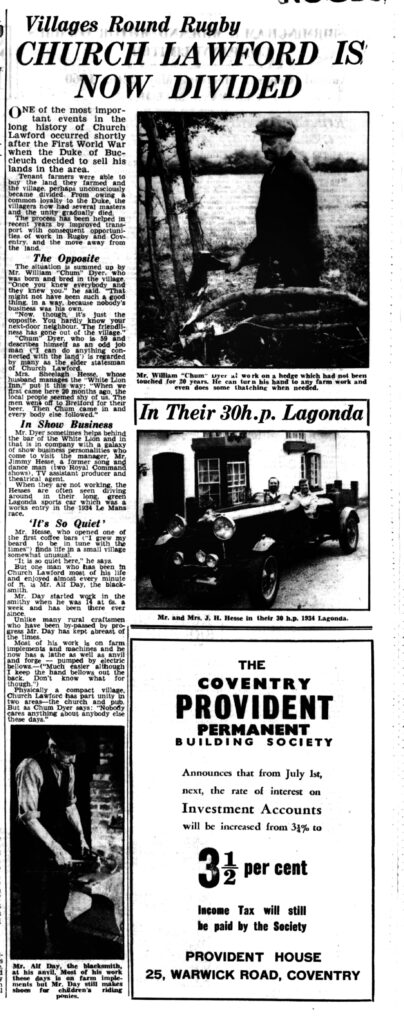The Coventry Evening Telegraph featured Church Lawford in May 1960.
One of the most important events in the long history of Church Lawford occurred shortly after the First World War when the Duke of Buccleuch decided to sell his lands in the area.
Tenant farmers were able to buy the land they farmed and the village, perhaps unconsciously became divided- From owing a common loyalty to the Duke, the villagers now had several masters and the unity gradually died.
The process has been helped in recent years by Improved transport with consequent opportunities of work in Rugby and Coventry. and the move away from the land.
The Opposite
The situation is summed up by Mr. William “Chum” Dyer, who was born and bred in the village. “Once you knew everybody and they knew you.” he said- “That might not have been such a good thing, in a way, because nobody’s business was his own.”
“Now. though, it’s Just the opposite. You hardly know your next-door neighbour. The friendliness has gone out of the village ”
Chum Dyer, who is 59 and describes himself as an odd Job man (“I can do anything connected with the land”) is regarded by many as the elder statesman of Church Lawford.
Mrs. Sheelagh Hesse, whose husband manages the “White Lion Inn,” put it this way: “When we first came here 20 months ago. the local people seemed shy of us. The men went off to Bretford for their beer. Then Chum came in and everybody else followed.”
In Show Business
Mr. Dyer sometimes helps behind the bar of the White Lion and in that is in company with a galaxy of show business personalities who come to visit the manager, Mr. Jimmy Hesse a former song and dance man (two Royal Command shows), TV assistant producer and theatrical agent.
When they are not working, the Hesses are often seen driving around in their long, green Lagonda sports car which was a works entry in the 1934 Le Mans race.
It’s So Quiet
Mr. Hesse, who opened one of the first coffee bars (“I grew my beard to be in tune with the times”) finds life in a small village somewhat unusual.
“It is so quiet here,” he says.
But one man who has been !n Church Lawford most of his life and enjoyed almost every minute of it, is Mr. Alf Day, the blacksmith.
Mr. Day started work in the smithy when he was 14 at 6s, a week and has been since.
Unlike many rural craftsmen who have been by-passed by progress Mr. Day has kept abreast of the times.
Most of his work is on farm implements and machines and he now has a lathe as well as anvil and forge – pumped by electric bellows. – (“Much easier, although I keep the hand bellows out the back. Don’t know what for though.”)
Physically a compact village, Church Lawford has part unity in two areas – the church and pub. But as Chum Dyer says: “Nobody cares anything about anybody else these days.”

